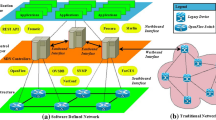Abstract
As a congestion avoidance mechanism, Explicit Congestion Notification (ECN) is designed to inform a data source to react to potential congestion early. Currently, the new transport protocol, Stream Control Transmission Protocol (SCTP), is not ECN-capable. An ECN-capable SCTP is proposed in this paper, which is bandwidth-efficient and robust to non-congestion losses. An SCTP source needs to adjust its congestion window when receiving ECN messages. We find the optimal value of the congestion window for an SCTP source in response to ECN messages, and develop a simple and practical method to achieve this optimal congestion window. Both simulation results and analysis are provided to support the effectiveness of the proposed ECN mechanism for SCTP. The simplified method in achieving the optimal congestion window is attractive because the total goodput performance of SCTP associations or the bottleneck link utilization is not sensitive to the window reduction policies when the network load is heavy. Using complicated methods to fine-tune SCTP or TCP’s congestion window in response to congestion indications may not be worth the increase in complexity of the protocol.
Similar content being viewed by others
References
B. Braden, et al., Recommendations on the queue management and congestion avoidance in the Internet, in: IETF RFC 2309 (April 1998).
A.L. Caro Jr., P. Amer and R. Stewart, Transport layer multihoming for fault tolerance in FCS networks, in: Proceedings of Collaborative Technology Alliances, Communications and Networks (April 2003).
S. Floyd, TCP and explicit congestion notification, ACM Computer Communication Review 24 (1994) 10–23.
S. Floyd and V. Jacobson, Random early detection gateways for congestion avoidance, IEEE/ACM Transaction on Networking 1(4) (1993) 397–413.
R.J. Gibbens and F.P. Kelly, Resource pricing and the evolution of congestion control, Automatica 35 (1999).
J. lyengar, A. Caro, P. Amer, J. Heinz and R. Stewart, SCTP Congestion Window Overgrowth During Changeover SCI 2002 (Orlando, June 2002).
M. Kwon and S. Fahmy, TCP increase/decrease behavior with explicit congestion notification (ECN), in: ICC (April 2002).
C. Liu and R. Jain, Improving explicit congestion notification with the mark-front strategy, Computer Networks 35(2/3) (2001) 185–201.
K. Ramakrishnan, S. Ployed et al., The addition of explicit congestion notification (ECN) to IP, in: IETF RFC 3168 (Sept. 2001).
R. Stewart, Q. Xie et al., Stream control transmission protocol, in: IETF RFC 2960 (Oct. 2000).
V. Tsaoussidis and I. Matta, Open issues on TCP for mobile computing, Wireless Communications and Mobile Computing 2 (Feb. 2002).
S. Xu and T. Saadawi, Revealing the problems with 802.11 MAC protocol in multi-hop wireless ad hoc networks, Journal of Computer Networks 38(4) (2002).
G. Ye, T. Saadawi and M. Lee, SCTP congestion control performance in wireless multi-hop networks, in: MILCOM’2002 (Oct. 2002).
N. Yin and M.G. Hluchyj, Implication of dropping packets from the front of a queue, in: 7-th ITC, Copenhagen, Denmark (Oct. 1990).
Author information
Authors and Affiliations
Corresponding author
Additional information
Prepared through collaborative participation in the Communications and Networks Consortium sponsored by the U.S. Army Research Laboratory under the Collaborative Technology Alliance Program, Cooperative Agreement DAAD19-01-2-0011. The U.S. Government is authorized to reproduce and distribute reprints for Government purposes notwithstanding any copyright notation thereon.
Guanhua Ye received the B.E. degree in Information & Electronic Technology from Zhejiang University, China, in 1997 and M.E. degree in Communication & Information Systems from China Academy of Telecommunications Technology in 2000. He is currently working toward the Ph.D. degree in Electrical Engineering at City College and Graduate Center of City University of New York.
His research interests are in computer networks, congestion control, ad hoc networks, voice over IP and multimedia communications.
Tarek N. Saadawi received the B.Sc. and the M.Sc. from Cairo University Egypt and the Ph.D from the University of Maryland, College Park (all in Electrical Engineering). Since 1980 he has been with the Electrical Engineering Department, The City University of New York, City College. His current research interests are telecommunications network, high-speed networks, multimedia networks, AD-HOC networks and packet radio networks. He has published extensively in the area of telecommunications networks. He is a Co-author of the book, Fundamentals of Telecommunication Networks,” John Wiley & Sons, 1994. He is also the lead author of Egypt Telecommunications Infrastructure Master Plan covering the fiber network, IP/ATM, DSL and the wireless local loop. Dr. Saadawi is a Former Chairman of IEEE Computer Society of New York City (1986–87). He has received IEEE Region 1 Award, 1987, and the Nippon Telegraph and Telephone (NTT) of America for research on Broadband Telecommunication Networks.
Dr. Myung Jong Lee received the B.S from Seoul National University in Korea and M.S and Ph.D degrees in electrical engineering from Columbia University, 1986 and 1990 respectively. He joined the Department of Electrical Engineering, City College and Graduate Center of City University of New York, where he is currently an associate professor.
His recent researches focus on various aspects of wireless ad hoc networks, sensor networks, and personal area networks. He has published over 50 refereed journal and conference papers. He is the Director of Samsung-CUNY Joint Laboratory on Sensor Networks. Dr. Lee received CUNY’s Excellence Performance Award in 1999. Dr. Lee is a senior member of IEEE, and served many IEEE and other conferences as program committee member and session chair, and also actively participates in ZigBee Alliance and IEEE1451 Smart Sensor WG.
Rights and permissions
About this article
Cite this article
Ye, G., Saadawi, T.N. & Lee, M. On Explicit Congestion Notification for Stream Control Transmission Protocol in Lossy Networks. Cluster Comput 8, 147–156 (2005). https://doi.org/10.1007/s10586-005-6180-x
Issue Date:
DOI: https://doi.org/10.1007/s10586-005-6180-x




